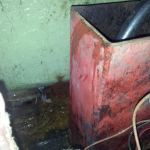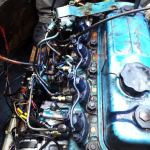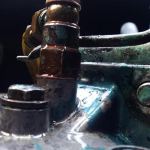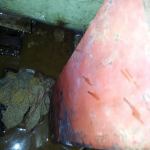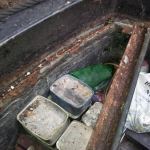Buying or renting a narrowboat is a good decision. But if you never have lived on a boat before – how can you check the condition of your new vessel? We have put together an extensive checklist (48 questions) for engine, heating, electric, exterior and interior.
Things you don’t want to see on a narrowboat:
The first question is: Are you buying or renting?
If you are renting the boat, make sure to have a clear contract. The landlord should pay for damages and problems at least regarding vital parts like hull, engine, electric system, toilet, bath/shower and heating.
If you are buying the boat, have it surveyed by a qualified Marine Surveyor who will advise of any faults on the hull and with the boat’s internal systems. Usually an extensive check will cost you around 300 GBP but is definitely worth the effort. If you want to be on the safe side, make a full “out of the water” survey to check the boat also from underneath. Marinas can arrange such a survey within 1-2 weeks.
In any case you should consider renting/buying the boat outside of areas with high costs of housing. We were renting our boat in Birmingham for 500 GBP in 2012. Prices in London are up to 1/3 higher.
If you check the boat yourself, ask an experienced boater to accompany you.
Answer the following questions. During your inspection, record all items that are damaged or will require replacement. You can use them later to get a discount on the price.
Engine
- What general age and condition does the engine have?
Newer boats have water-cooled diesel engines. Older boats have noisier air-cooled engines. Our boat was equipped with a vintage BMC, which is generally not a handicap because older models are still easier to repair then newer ones.
If the engine room is clear and in order, and the engine block is clean from oil and dirt, it indicates basically a good service.
Be aware of tricks:
- is the engine block super clean and maybe freshly painted? This could indicate a high pressure waterblasting just for the sale. In fact, our second-hand engine had decent rust below a nice blue painting.
- are there any signs of glue? Hard to believe, but our engine was partly made proof with glue instead proper fixing. Of course this was leading to problems later.
- gearbox: Are there any leaks from the stern gear? If there are, it may need repacking or adjusting.
- Can you see any sort of leaks? Dark brown oil stains can indicate a leak in a gasket which could lead to an expensive repair.
- Is the water in the engine room contaminated with oil? This would indicate heavy leaks.
- Is the oil filler neck not coated with thick, black deposits?
- Check the dipstick – The oil should ideally be pink or red. Within old boat engines you will find mostly dark color, but in any case it shouldn’t smell burnt.
- Start the engine from cold: is it easy to start? Are there any abnormal noises?
- Does the oil warning light go out as soon as the engine starts?
- Are there any signs of excessive visible exhaust emissions? The smoke should be white (water burning) just in the beginning when the engine is cold. Older engines can have a slightly blue smoke (oil burning), but never should be black – this indicates heavy oil burning and serious engine problems.
- Let the engine run for a while with slightly higher revs – does the temperature stay in the green / neutral area (usually around 70-80 degrees C) or does it go up to unhealthy 90-100 degrees?
Batteries
- Are there at least 2-3 leisure batteries coupled with one starter battery?
- Is there a good battery management system regulating the flow of current into the batteries?
- Does it have a protection for overcharging and complete discharge?
- Does it have a permanent voltmeter to easily check the state of charge?
- Does the boat have an electrical hookup & cable (when mooring inside a marina)?
- Does the boat has an inverter to convert 12 volt battery power to 240 volts? You can recognize a good inverter on the size – usually the bigger, the better. If you don’t have an inverter, you’ll be unable to run electrical equipment.
- Ask the owner or check yourself how long you can run the appliances without recharging the batteries. Depending on the load (lights, water pump, TV, 12V fridge), the batteries should keep at least for a day. Listen carefully to any undertones. The batteries are vital and expensive.
- If it’s a liquid battery – Is it properly serviced? Remove the battery vent plugs and check the liquid level. Does it cover the top of the plates?
- Apply a digital voltmeter. 12.6 V + indicate full charge, 12.06 V are 50%, less then 11,58 V are critically (20%). 10.5 V are 0%, left like this for more then a week will completely destroy the battery (sulphation).
- Check the price of the battery model with your smartphone. Batteries below 90 GBP will usually do max. 300 deep discharges.
- Is the boat equipped with solar panels? Good! 150W are enough for lights and water pump even in the winter. 300W are needed to run a 12V fridge or TV.
Exterieur
- How is the general impression? Has the boat been well looked after?
- When was the hull last blacked? A narrowboat hull needs to be pressure washed and painted with bitumen every two to three years in a dry dock to protect the steel from corrosion – especially around the waterline. Take care, sometimes even new boats can suffer premature pitting.
- How is the condition of the hull? Steel thickness should be 10mm on the hull base, 6mm on the sides and 4mm on the roof.
- Check painting with a little hammer for rust underneath.
- Is the narrowboat long enough? For living aboard you should go for 52-72ft length, or wide beam (15ft width).
- Check varnishing and onboard equipment. Are there central, fore and aft ropes for easy mooring, a windlass (lock key) and mooring pins?
- Lies the boat right / left balanced in the water? If not, you need to balance it with weights.
- How much water is in the engine room (around and below the engine)?
When the propeller is not sealed well, if there are other leaks, or the rain drainage is not working, the water level can increase within 1-2 weeks to a dangerous level.
This happened to us once, and we know boats that have been sunken because of water in the engine room.
Interieur
- Check for the smell of damp and mould – this means that water is inside the boat.
If you can smell a heavy air freshener, suspect it – what’s it hiding? - Are fridge, cooker, lights, heating system and shower in good working order? Go through all appliances of the boat one by one.
- Is the boat equipped with a solid fuel stove and / or with gas/diesel heating? Gas/diesel burners can run radiators and provide hot water quickly – but they are lacking a warm glow in the lounge area.
Personally, I liked our little stove with glass window – it’s better then TV. - Is there a central water heating or just one stove for all the boat? Check if the radiators are working.
On our boat, the stove in the living area was not powerful enough to heat all the boat – that’s why we couldn’t use the second room all winter long. - Is the boat’s ceiling high enough? Can you stand comfortably inside the boat when you are tall?
- Is there a bath or a shower on board? Check if the hot water supply is working, and if there are any leaks inside the system/boiler.
- How much storage space do you have? General advice: the more, the better. Look inside the wardrobe and smell for mould.
- Are there any signs of water under windows/hatches?
Every boat is wet from the inside – the only question is how much. - Have a look in cupboards and hatches. Look for hatches through the floor into the bilge, i.e. below shower, kitchen. Be wary if you find any water in the bottom of the boat.
- Does the boat have a pump-out toilet or portable cassette? Pump-outs have a fixed tank which can be emptied at a pump-out station for a small fee. Portable toilets (Porta Potti) are more flexible, can be emptied easier and usually without a fee – but you need to do this more frequently and carry your own excrements.
Documents
- If the boat is under four years-old it must have a Recreational Craft Directive certificate (Class D Inland Waters).
- Boats over four years old need a Boat Safety Certificate. The safety certificate ensures engine, heating-, gas- and electric-system, ventilation and fire extinguishers have been checked and approved.
- Does the boat have a service history and invoices?
- Is a reasonably recent hull survey available?
- Do you have a third party insurance for at least £1,000,000? (necessary for CRT license)
- Do you have additional insurance against loss or damage, fire & theft, cover for the safety of the crew and the contents? Especially when you are planning to stay in the London area narrowboats are an easy targets for thieves. (We had 2 break-ins within a year’s time)
